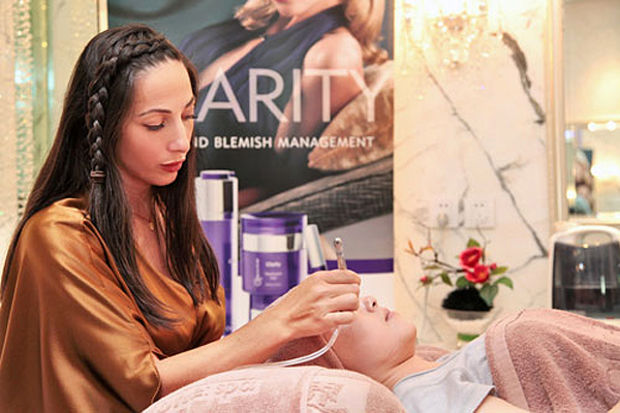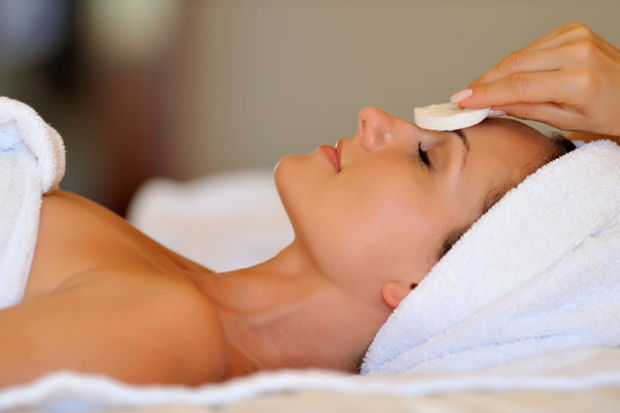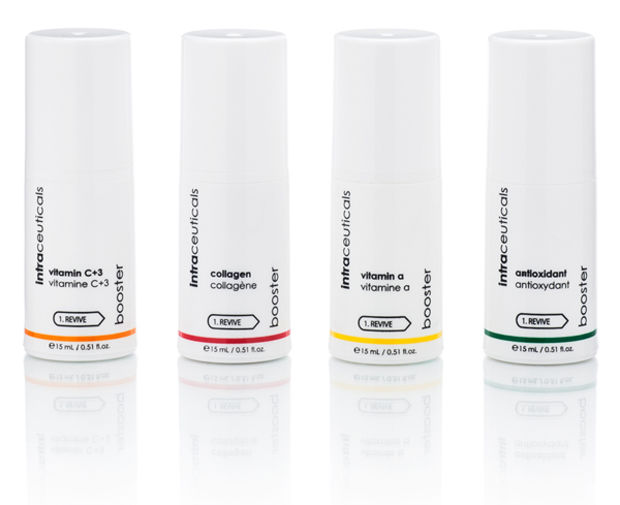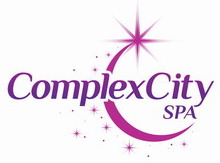
We all know celebrities have more than a few tricks up their sleeves for looking party-ready and picture-perfect. (And you’re especially aware of this if you’ve been reading our before and after series.) But aside from the little plastic surgery tweaks and Restylane jabs, one of the biggest celebrity beauty secrets is the oxygen facial.
You’ve probably had one yourself, or at least heard of them, since they’ve been around for a decade now at spas, medi-spas and select dermatologist’s and plastic surgeon’s offices. While the basic mechanism has remained the same—a pressurized stream of oxygen that delivers active ingredients to the skin—the quality of those actives has recently been upgraded from basic moisturizers to fancy stuff like hyaluronic acid, antioxidants and peptides (but more on that in a sec).
Celebs love ’em because they make skin look more plumped-up and glowy before a performance or red carpet appearance. So with party season coming up, should YOU follow suit with an oxygen facial before the big events in your life? Let’s investigate!
What is an oxygen facial?
I’ve had a few oxygen facials over the years, most recently a few months back at Toronto’s Ritual spa when Madonna’s makeup artist and Intraceuticals spokesperson Gina Brooke was in town. (You may remember Gina from this Make Up For Ever event last year, another brand that she works with and loves.)

Intraceuticals is an Australian company that first pioneered the treatment in 2002 and still has the biggest following. They have a few competitors now, but the main difference is that with their facial, you’re not just getting a stream of oxygen; it literally pushes high-tech skincare ingredients into your skin as well. This is their fancy machine:

I got to sit down for a chat with Gina before my treatment. “We’re using oxygen under pressure to deliver a special serum with low molecular weights of hyaluronic acid to the skin,” she told me. “In Australia, they were using this system to deliver chemotherapy to skin cancer patients. The delivery system is incredible.”
What to expect at an oxygen facial
Here’s how a typical appointment will go down. Since oxygen facials are usually offered in more medical environments, you shouldn’t expect the same frou-frou extras you’d get with a regular facial (which you already know my feelings on, anyway). There’s no aromatherapy, no facial massage, no ritualistic product-layering like you get at a luxury spa. It’s a much more no-nonsense, results-oriented approach.
After ushering you into the treatment room, your aesthetician will first cleanse (and usually exfoliate) your skin.

Then she (or he; you never know!) will analyze your skin to determine which infusion would suit you best. This is the new innovation versus Intraceuticals’ earlier version of the treatment, which was one size—er, serum—fits all.
There are four treatment options, each serum featuring a targeted blend of hyaluronic acid, botanical extracts, antioxidants, peptides and/or vitamins:
- Rejuvenate diminishes the appearance of fine lines and wrinkles while enhancing overall hydration.
- Opulence helps uneven skin tone look brighter and more luminous.
- Clarity calms acne while restoring moisture balance and defending against future breakouts.
- Atoxelene is a needle-free Botox alternative that helps to soften and firm expression lines, define the eye contour and plump the lips.
The key ingredient is really the hyaluronic acid, a molecule that is found naturally in our skin (and is also the substance in most injectable fillers); it attracts and binds moisture, therefore helping skin look firmer and more hydrated.
The infusion of your choice is first sprayed on your skin and then the oxygen is delivered via a wand that looks like this:

The device—which “is very similar to a makeup artist airbrush gun,” says Gina—emits a continuous flow of 90 to 95 percent pure oxygen under hyperbaric pressure (compared to the 18 to 21 percent naturally in our environment). This is said to enhance the absorption of the serums so you theoretically get more benefit from the ingredients. Oxygen is also naturally antibacterial and has a cooling, calming effect.
The infusing feels like a blast of cold air on the skin, with a slight pressure but nothing painful or uncomfortable. Once your aesthetician slowly makes his or her way around your entire face with the wand, you’ll get one of their topical serums and/or creams applied on top (a process Intraceuticals calls “hyaluronic layering”).
The whole process takes about 30-60 minutes, and then you can also buy products to help maintain your results at home. The brand has recently come out with four booster serums that you can mix and match to customize your regimen:

- The Vitamin C+3 Booster is for all skin types and helps even out irregular skin tone and sun damage.
- The Collagen+ Booster is packed with peptides for restoring volume and tightness to skin that’s lost elasticity, tone and density.
- The Vitamin A+ Booster “is great for oily or acneic skin, or if you have really visible pores,” says Gina. “It also helps resurface fine lines and wrinkles like a traditional retinol product. It’s been formulated to have a buffer, so it’s not as irritating as other retinols.”
- The Antioxidant+ Booster is Gina’s favourite. “It really does give your skin that boost when it looks tired and kind of sad, the same way you would drink a green juice when you feel blah. It also has more natural ingredients than the others.”
I’m a bit of a serum junkie, so I LOVE the concept of these and that you can use different ones depending on what your skin needs. I’m a longtime user of SkinCeuticals’ antioxidant serums, as well as various vitamin A topicals, so it’s very exciting to have new alternatives that are of similar quality and equally lightweight!
Oxygen facial benefits
So does the oxygen facial actually work? Well, speaking from my own experience, the short-term proof is in the mirror. Every time I’ve had an oxygen facial, the results were instant and noticeable. You really do glow when you walk outta there.
But Gina can probably talk it up better than I can. Over to her:

“I found Intraceuticals in 2004 at a time when I was doing mostly beauty campaigns and lots of the models and celebrities were showing up on set and their skin was… not the best. For example, some of them had not just dehydrated skin but acne, eczema, rosacea, psoriasis. And no matter what I did, I couldn’t make the skin look as beautiful as I wanted to. No matter what makeup, it just didn’t help. I tried expensive creams; I tried non-expensive creams; nothing seemed to work.
“So I called a doctor friend of mine and I told her my problem and she said, ‘Oh, I have this amazing system from Australia; come and I’ll prove it to you.’ I’m very skeptical. She did one side of my face and then showed me a mirror and I looked at the other side, untouched. It was a remarkable difference. It looked healthy, like I just came back from vacation. I thought wow, this is amazing but let me see how it is with makeup. Will it work? I went home, I did my makeup and it looked beautiful.
“It’s like working on a clean canvas. When your skin is dry, your makeup lays on top of it and you can’t actually see the skin through it. After I do an Intraceuticals treatment, makeup looks like second skin celebrex price. It doesn’t look like makeup. So when you’re painting over the face, it’s just like a clean canvas and the makeup looks more beautiful, the skin’s more hydrated, it’s tighter, it’s smoother, it’s more plump, it’s firm.”
Celebrity fans of the oxygen facial
Obviously celebs were the first to get on board, since they’re being photographed all the time, and Madonna is the most famous fan of all. She always travels with her $14,200 Intraceuticals oxygen machine and also has one in each of her six homes (!!). Injectables aside, you have to admit that her skin tone and texture look amazing. She is 55 years old, BTW:

Victoria Beckham, Justin Timberlake and Jessica Biel and (shocker) Kim Kardashian also all own their own oxygen machines.

And guess what? Gina’s the one who introduced them to it, after test-driving the procedure on herself.
“I thought, okay, I’m going to introduce this to some of my clients. Everyone from Madonna to Katy Perry to Justin Timberlake to Victoria Beckham to Naomi Campbell, they all discovered it and they were shocked at how amazing it was. They said, ‘Wow, I’ve never tried anything like this’ or ‘I noticed my skin change drastically for the better.’”

“Most celebrities have it done more often [than the recommended treatment schedule] because they’re on planes every day, and it just zaps all the moisture out of your skin. So in that case, for example Madonna or Justin Timberlake or Katy Perry, these people take it on tour with them. They have to do a treatment every day or every other day so that their skin looks incredible on stage.”
I asked Gina if it was possible to overdo it by having too many treatments, but she said no. “I’ve been using it since 2004 and I have never had anything negative happen; in fact, I’ve only had the best results.” There are no side effects and it’s safe for all ages and skin types.

What’s extremely compelling is the long list of unpaid celebrity testimonials, which you can see on Intraceuticals’ website. “Not one person was paid a single penny. You can’t say any other skincare brand on the market that has a list of the most iconic celebrities in the world who swear by Intraceuticals, yet they haven’t been paid.”

“My clients like to say, it’s instant gratification. Because when I’m working on set, I don’t have the luxury of waiting three weeks for a product to work. I need something right away, especially for someone who has eczema or psoriasis or rosacea. It calms the skin, it gets rid of redness, it tightens, it firms, it plumps the skin.
“I even have photographers and producers asking me to bring it on video shoots. Normally there’s a $20,000 to $100,000 budget for visual imaging. There’s a guy that sits in front of a computer screen and frame for frame, he’s cleaning every little section of the face to make sure it looks flawless. Since I’ve been using Intraceuticals, it’s cut the retouching budget in half. After I do the skin treatment, the skin looks like it’s been airbrushed. It’s incredible.”
Oxygen facials versus invasive treatments
So why would you splurge on a series of oxygen facials when you could just deal with the signs of aging by going under the needle—or knife? Here’s Gina’s take:
“I’m all for making oneself feel better, whether it’s filler or anything. But in Hollywood and in general, there are people who’ve taken it way too far. I think why people love the treatment so much is because it makes you look like a better version of yourself. You look like you’ve just come back from vacation; you look well-rested. It’s non-invasive and you don’t have to worry if there’s going to be any kind of problem after the treatment.”
How long do the oxygen facial results last?
Unfortunately, not that long considering treatments typically cost around $150 to $200; higher than the average traditional facial. Gina says your skin will look “incredible” for four to seven days—which is fine if you’re doing it for a special occasion, but don’t expect to notice any lasting results from a single treatment.
“It’s ideal for women who are getting married, because they get married, they go on their honeymoon and their skin is glowing for days,” says Gina and I agree with this. It would also be great as prep for a series of holiday parties, New Year’s Eve, a school reunion or anything else that requires your complexion to be in tip-top shape.
I just don’t think it’s realistic for the average non-celebrity person to afford the number of sessions you need for longer-term results. The brand says there is a cumulative benefit from regular treatments and recommends doing one facial per week for a period of six weeks, and then once a month thereafter to maintain your results. Obviously, celebrities can totally afford this (a minimum $900 investment before you go on maintenance mode) but most people, no.
Do oxygen facials cause inflammation?
There are other concerns about oxygen facials besides the cost. I first wrote about the treatment in the late ’00s for ELLE Canada, and the dermatologists I interviewed for that article told me the plumped-up glow was not from the oxygen or the hyaluronic acid at all… but instead from the irritation and inflammation of the skin.
The exact same view was noted by a dermatologist quoted in this 2006 New York Times article:
“The concept that high-pressure oxygen would do anything to help the skin is such nonsense as to be laughable,” said Dr. Zachary, who has not examined the oxygen-compression machine himself.
He suggested that the plumping or swelling effect might be mild inflammation caused by the blasts of compressed oxygen. “If you wanted puffy eyes, you could also go out for a hard night’s drinking,” he said.
Oh noes. And as Dr. Fredric Brandt also points out, there is no scientific proof that the oxygen actually drives the nutrients deeper into the skin or has any other skin benefit.
It’s funny, though. Since that time, I can’t tell you how many derms and plastic surgeons have started offering the treatments in their own offices and medi-spas… which sort of makes one question their credibility. Did they change their minds on its effectiveness or are they just trying to make money? Hmm….
Do oxygen facials cause free radical damage?
The other concern is that oxygen itself promotes the creation of free radicals—a key contributor to aging—and so why would you deliberately want to make more of them right on your face?
I have to say, this part worries me the most. Have you ever noticed how the beauty biz perpetuates these conflicting positions on oxygen? On the one hand, it’s enemy number one and we have ANTIoxidant skincare products galore to prevent an aging Armageddon. But then we’re also supposed to “oxygenate” our tissues with these treatments for skincare benefits. Doesn’t make a whole lotta sense
Here’s the brand’s response: “There is no evidence that oxygen treatments cause free radical damage; in fact most scientists and physicians argue that even if topical oxygen could penetrate the skin it would be such an insignificant amount; basically no more than your daily exposure to oxygen.”
Fair enough, but here’s where I stand:
The bottom line
For me, oxygen facials will remain more of a special occasion thing—since I don’t have a celebrity-style bank account—and so I don’t think the temporary inflammation or potential free radical damage is anything too major to worry about. (If I were Madonna, having this done every day? Well, then I’d probably be a little concerned.)
But getting the treatments just a few times a year is likely no problem. And really, you can’t argue with the short-term results. They.Are.Amazing. Just look at Miranda Kerr here:


Now, if I were seriously concerned about dull, aging skin and had upwards of $900 to spend on improvements, I have to be honest. I’d probably invest in other things before oxygen facials—even if there were no concerns about free radicals and skin inflammation. Yes, the testimonials are amazing, but I’d likely prioritize my money towards filler, Botox or Fraxel treatments first. I see the facials as more of a secondary add-on to interventions that produce more dramatic and longer-lasting results.
Next week, I’ll be talking about a NEW treatment that’s a twist on the oxygen facial but for some doctors, is actually replacing it because they think it’s even better. Stay tuned—and in the meantime, let’s talk about this!
Have your say
Have you ever had an oxygen facial?
Do you think it has real skin benefits or do the free radicals and inflammation worry you?
Would you invest in a series of treatments or would you rather spend your “skincare money” elsewhere?





